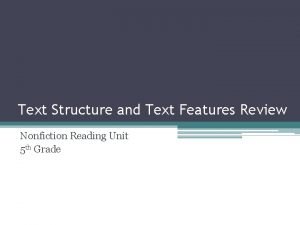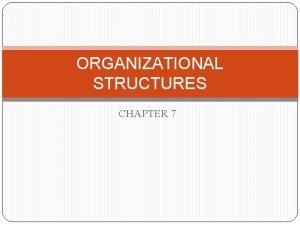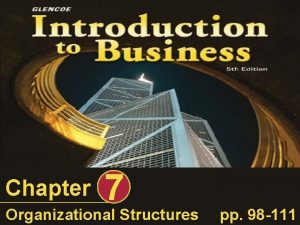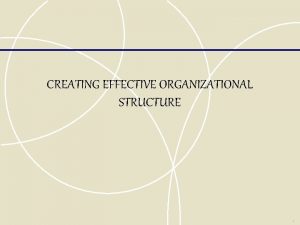Organizational Text Structures Why the need for organizational










- Slides: 10

Organizational Text Structures • Why the need for organizational text structures? To help the reader understand the information presented. • Consider your purpose when recognizing a text structure

External Text Structures External text structures are found outside the main body of text. They include: • Italics • Bold • Underlining • Indentation • Sidebars • Pictures and graphics • Headings and subheadings • Footnotes

Internal Text Structures Internal text structure is how the main body of the text is organized. It will be organized a certain way depending on its purpose. There are 7 different internal structures: • • Cause and Effect Comparison and Contrast Enumeration/Listing Sequential or Chronological Concept/Definition Generalization Process

Sequential/Chronological • It tells the order of facts, events, or concepts • Signal words/phrases: • Today * Next • Meanwhile • First • Now • Not long ago • Finally Examples: timelines, records of history events

Comparison and Contrast • Tells how facts, people, and events and concepts are similar and different • Signal words/phrases: – Similarly – On the other hand – However – Yet – In spite of

Cause and Effect • Tells how fact, events, people, concepts happen or exist because of other facts • Signal words/phrases: – As a result of – Consequently – So that – Because of – Since Examples: history books, science books

Enumeration/Listing • Tells a listing of facts and events in no special order • Signal words/phrases: – Also – Another – Several – First Examples: grocery list, listing of examples

Concept/Definition • Tells the explanation or description of a concept or topic by using synonyms and signal words • Signal words/phrases: – Refers to – Thus – In other words – Described as – Equals Example: textbooks, encyclopedias

Generalization • A statement about a whole group. Could be too broad and not based on fact. Often the word "all" will make a generalization untrue. "All trees lose their leaves in the fall. ” • Signal words/phrases: – Always – In fact Examples: editorials, advertising

Process • Tells the procedure or process for how something is done/created • Signal words/phrases: – Begins with – In order to Examples: cookbooks, how-to books, science textbooks
 Making connections
Making connections Pictures
Pictures Poster showing the timeline of development of gadgets
Poster showing the timeline of development of gadgets Kyssande vind
Kyssande vind Homologous structures example
Homologous structures example Don't ask why why why
Don't ask why why why Lattice organizational structure
Lattice organizational structure What is the organizational structure of a school
What is the organizational structure of a school Chapter 7 organizational structures
Chapter 7 organizational structures Influences of organizational structures on projects
Influences of organizational structures on projects Sbu organizational structure
Sbu organizational structure



















